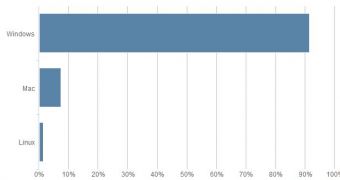With Windows XP support coming to an end, we’re seeing more and more users looking for alternatives for Microsoft’s operating system and it’s no surprise that many are actually going for Linux.
The reasons behind such a dramatic change is pretty much related to costs and security, even though in many cases it takes a lot more time to get used to the new platform.
Since so many people are making the move to Linux, we took to Net Applications to find out whether the Windows vs. Linux battle is indeed getting fiercer and if Microsoft’s operating system is indeed at risk of losing its supremacy in the OS market.
As you can see in this graph for the last year, Windows continues to be the clear leader of the OS industry with no less than 91.34 percent, which is good enough to ensure a multi-year domination that’s very likely to continue many years from now.
What’s a bit worrying for Microsoft though is the fact that Linux continues to get more ground, especially because some users are disappointed with the latest Windows versions and are looking for alternatives that would better address their needs.
In 2013, for example, Linux has improved its market share from 1.17 percent in March to no less than 1.73 percent in December, with the growth very likely to continue this year. If the same ascending trend is maintained, Linux has all the chances in the world to surpass 2 percent, while Microsoft’s Windows would obviously lose ground and drop its market share.
Microsoft, on the other hand, is planning to take over the desktop world with several improvements for the modern Windows, including the return of the Start Menu and options to run Metro apps right on the desktop.
A so-called rapid release cycle strategy is also supposed to bring Windows versions to the market very fast, with Windows 9 very likely to see daylight in April 2015.

 14 DAY TRIAL //
14 DAY TRIAL //